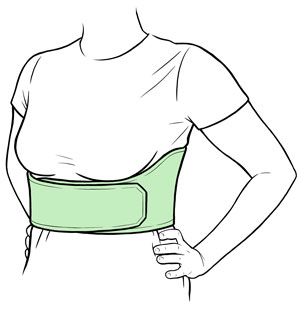A rib belt is an elastic strap. It may help reduce pain from chest muscle strain or rib fracture. The belt limits motion in the chest. It can help relieve pain from the chest wall and ribs. But, if worn too long, the rib belt may cause pneumonia or other problems. This is because it reduces the air flow into your lungs. You can help prevent this problem by doing the breathing exercises below.
Breathing exercises
Do this once an hour while you're awake:
-
Open the belt and take several very deep breaths.
-
As you breathe out, purse your lips as if you're blowing up a balloon. If possible, blow up a real balloon or a rubber glove.
This exercise builds up pressure inside the lung. It prevents collapse of the small air sacs of the lung. This exercise may cause some pain at the site of injury, which is normal. You may also be given an incentive spirometer for this purpose. This is a plastic device you breathe into.
Call 911
Call
-
Shortness of breath.
-
Increasing chest pain with breathing.
-
Dizziness, weakness, or fainting.
-
New or worse abdominal pain.
When to call your doctor
Contact your health care provider right away if:
-
Pain over the injured area gets worse.
-
You have a fever of 100.4°F (38°C) or higher, or as directed by your provider.
-
You have chills.


